NURS20161 Assignment 2: Australian Identity and Nursing Care Report
VerifiedAdded on 2022/09/14
|13
|3844
|15
Report
AI Summary
This report delves into the critical aspects of Australian identity and its implications for nursing care, particularly focusing on Aboriginal and Torres Strait Islander peoples and victims of domestic violence. It begins by analyzing the author's personal attitudes towards these groups using a critical reflection framework, exploring how these attitudes might influence the provision of nursing care. The report then examines the impact of colonization on domestic violence rates within Indigenous communities, highlighting historical and systemic factors. Finally, it proposes practical approaches nurses can take to provide culturally safe care, emphasizing the importance of understanding cultural safety, respecting traditions, and adopting interventions that promote wellbeing and health improvements for Indigenous Australians. The report provides insights into potential biases and offers strategies for fostering a respectful and equitable healthcare environment.
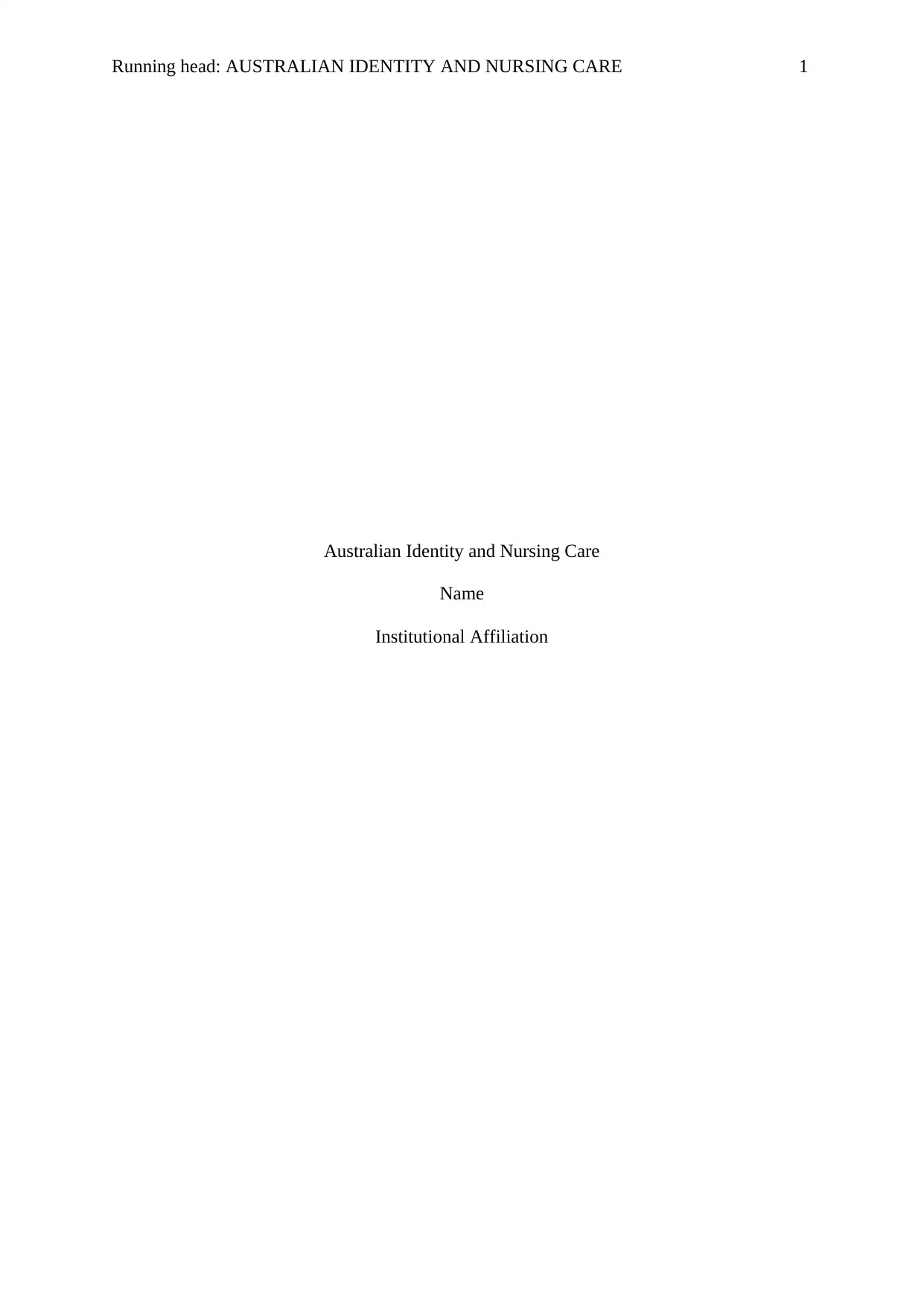
Running head: AUSTRALIAN IDENTITY AND NURSING CARE 1
Australian Identity and Nursing Care
Name
Institutional Affiliation
Australian Identity and Nursing Care
Name
Institutional Affiliation
Paraphrase This Document
Need a fresh take? Get an instant paraphrase of this document with our AI Paraphraser
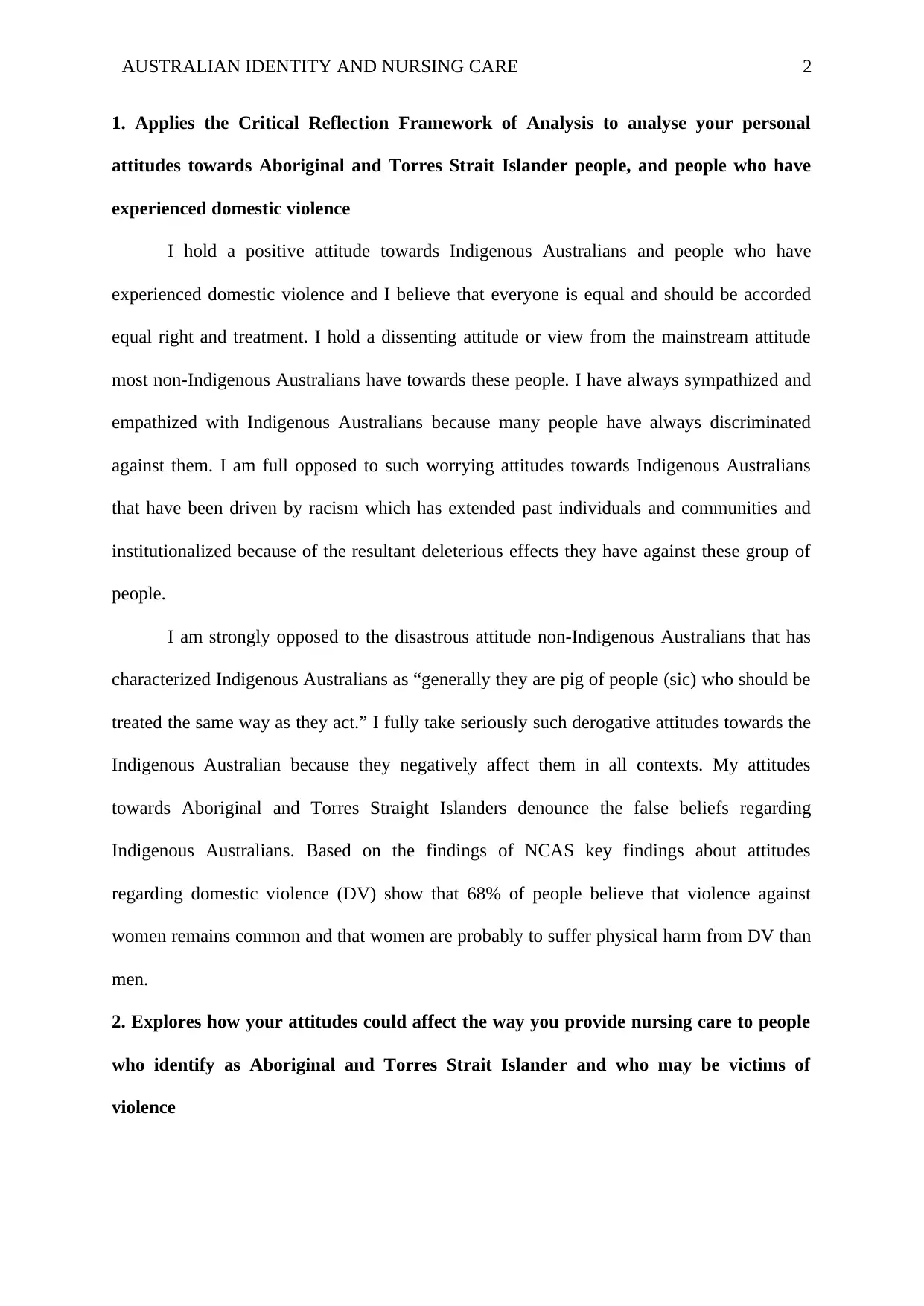
AUSTRALIAN IDENTITY AND NURSING CARE 2
1. Applies the Critical Reflection Framework of Analysis to analyse your personal
attitudes towards Aboriginal and Torres Strait Islander people, and people who have
experienced domestic violence
I hold a positive attitude towards Indigenous Australians and people who have
experienced domestic violence and I believe that everyone is equal and should be accorded
equal right and treatment. I hold a dissenting attitude or view from the mainstream attitude
most non-Indigenous Australians have towards these people. I have always sympathized and
empathized with Indigenous Australians because many people have always discriminated
against them. I am full opposed to such worrying attitudes towards Indigenous Australians
that have been driven by racism which has extended past individuals and communities and
institutionalized because of the resultant deleterious effects they have against these group of
people.
I am strongly opposed to the disastrous attitude non-Indigenous Australians that has
characterized Indigenous Australians as “generally they are pig of people (sic) who should be
treated the same way as they act.” I fully take seriously such derogative attitudes towards the
Indigenous Australian because they negatively affect them in all contexts. My attitudes
towards Aboriginal and Torres Straight Islanders denounce the false beliefs regarding
Indigenous Australians. Based on the findings of NCAS key findings about attitudes
regarding domestic violence (DV) show that 68% of people believe that violence against
women remains common and that women are probably to suffer physical harm from DV than
men.
2. Explores how your attitudes could affect the way you provide nursing care to people
who identify as Aboriginal and Torres Strait Islander and who may be victims of
violence
1. Applies the Critical Reflection Framework of Analysis to analyse your personal
attitudes towards Aboriginal and Torres Strait Islander people, and people who have
experienced domestic violence
I hold a positive attitude towards Indigenous Australians and people who have
experienced domestic violence and I believe that everyone is equal and should be accorded
equal right and treatment. I hold a dissenting attitude or view from the mainstream attitude
most non-Indigenous Australians have towards these people. I have always sympathized and
empathized with Indigenous Australians because many people have always discriminated
against them. I am full opposed to such worrying attitudes towards Indigenous Australians
that have been driven by racism which has extended past individuals and communities and
institutionalized because of the resultant deleterious effects they have against these group of
people.
I am strongly opposed to the disastrous attitude non-Indigenous Australians that has
characterized Indigenous Australians as “generally they are pig of people (sic) who should be
treated the same way as they act.” I fully take seriously such derogative attitudes towards the
Indigenous Australian because they negatively affect them in all contexts. My attitudes
towards Aboriginal and Torres Straight Islanders denounce the false beliefs regarding
Indigenous Australians. Based on the findings of NCAS key findings about attitudes
regarding domestic violence (DV) show that 68% of people believe that violence against
women remains common and that women are probably to suffer physical harm from DV than
men.
2. Explores how your attitudes could affect the way you provide nursing care to people
who identify as Aboriginal and Torres Strait Islander and who may be victims of
violence
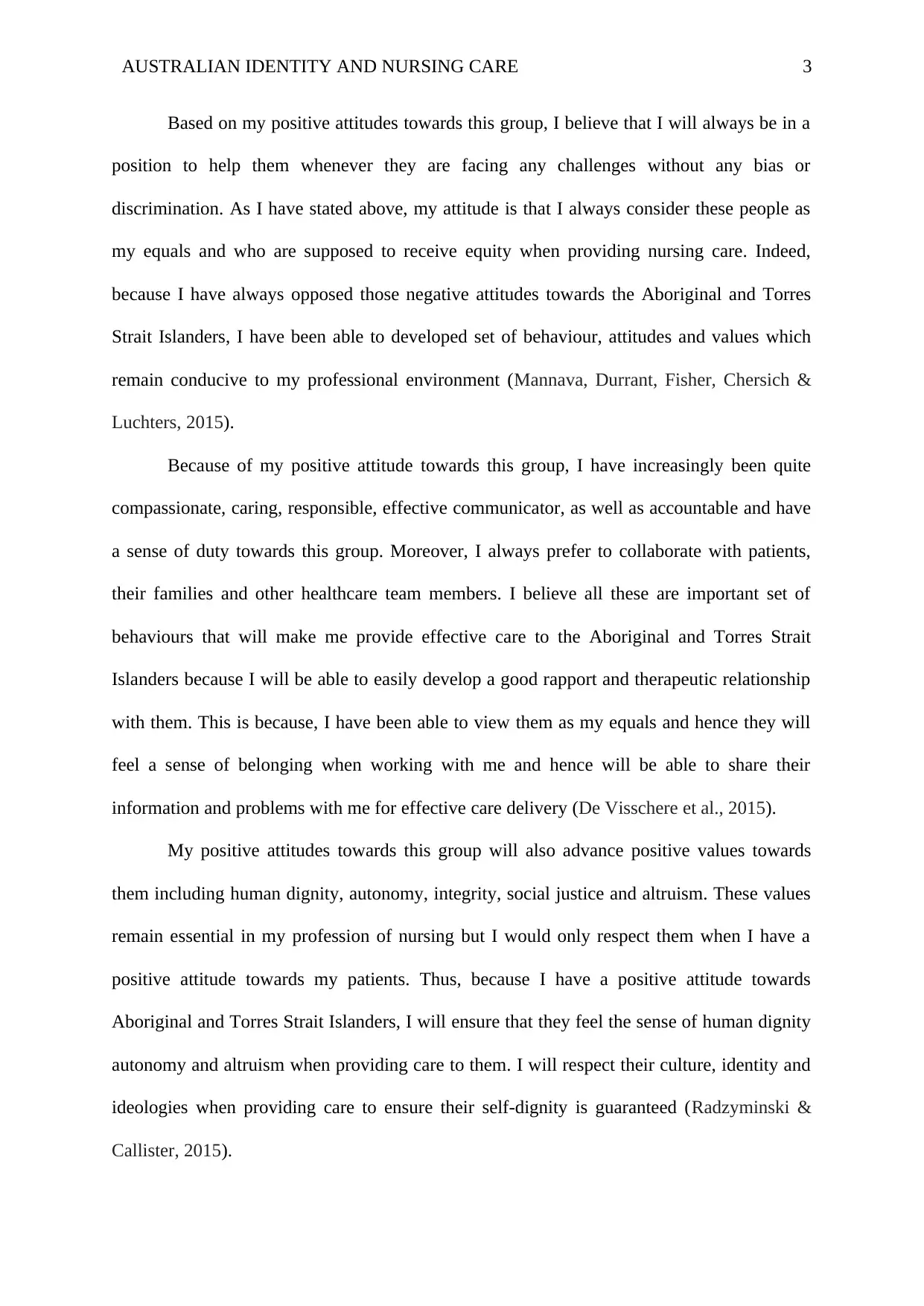
AUSTRALIAN IDENTITY AND NURSING CARE 3
Based on my positive attitudes towards this group, I believe that I will always be in a
position to help them whenever they are facing any challenges without any bias or
discrimination. As I have stated above, my attitude is that I always consider these people as
my equals and who are supposed to receive equity when providing nursing care. Indeed,
because I have always opposed those negative attitudes towards the Aboriginal and Torres
Strait Islanders, I have been able to developed set of behaviour, attitudes and values which
remain conducive to my professional environment (Mannava, Durrant, Fisher, Chersich &
Luchters, 2015).
Because of my positive attitude towards this group, I have increasingly been quite
compassionate, caring, responsible, effective communicator, as well as accountable and have
a sense of duty towards this group. Moreover, I always prefer to collaborate with patients,
their families and other healthcare team members. I believe all these are important set of
behaviours that will make me provide effective care to the Aboriginal and Torres Strait
Islanders because I will be able to easily develop a good rapport and therapeutic relationship
with them. This is because, I have been able to view them as my equals and hence they will
feel a sense of belonging when working with me and hence will be able to share their
information and problems with me for effective care delivery (De Visschere et al., 2015).
My positive attitudes towards this group will also advance positive values towards
them including human dignity, autonomy, integrity, social justice and altruism. These values
remain essential in my profession of nursing but I would only respect them when I have a
positive attitude towards my patients. Thus, because I have a positive attitude towards
Aboriginal and Torres Strait Islanders, I will ensure that they feel the sense of human dignity
autonomy and altruism when providing care to them. I will respect their culture, identity and
ideologies when providing care to ensure their self-dignity is guaranteed (Radzyminski &
Callister, 2015).
Based on my positive attitudes towards this group, I believe that I will always be in a
position to help them whenever they are facing any challenges without any bias or
discrimination. As I have stated above, my attitude is that I always consider these people as
my equals and who are supposed to receive equity when providing nursing care. Indeed,
because I have always opposed those negative attitudes towards the Aboriginal and Torres
Strait Islanders, I have been able to developed set of behaviour, attitudes and values which
remain conducive to my professional environment (Mannava, Durrant, Fisher, Chersich &
Luchters, 2015).
Because of my positive attitude towards this group, I have increasingly been quite
compassionate, caring, responsible, effective communicator, as well as accountable and have
a sense of duty towards this group. Moreover, I always prefer to collaborate with patients,
their families and other healthcare team members. I believe all these are important set of
behaviours that will make me provide effective care to the Aboriginal and Torres Strait
Islanders because I will be able to easily develop a good rapport and therapeutic relationship
with them. This is because, I have been able to view them as my equals and hence they will
feel a sense of belonging when working with me and hence will be able to share their
information and problems with me for effective care delivery (De Visschere et al., 2015).
My positive attitudes towards this group will also advance positive values towards
them including human dignity, autonomy, integrity, social justice and altruism. These values
remain essential in my profession of nursing but I would only respect them when I have a
positive attitude towards my patients. Thus, because I have a positive attitude towards
Aboriginal and Torres Strait Islanders, I will ensure that they feel the sense of human dignity
autonomy and altruism when providing care to them. I will respect their culture, identity and
ideologies when providing care to ensure their self-dignity is guaranteed (Radzyminski &
Callister, 2015).
⊘ This is a preview!⊘
Do you want full access?
Subscribe today to unlock all pages.

Trusted by 1+ million students worldwide
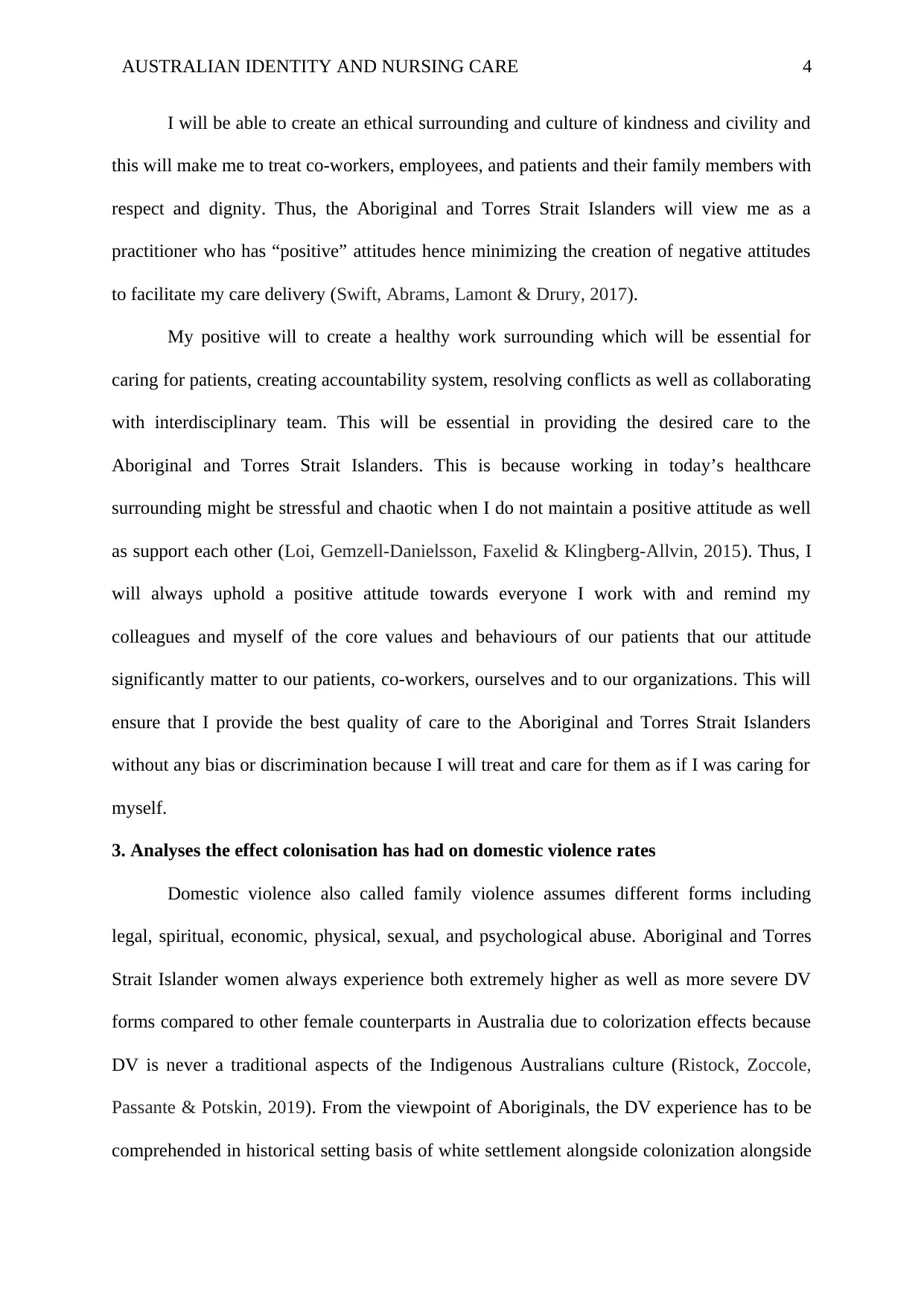
AUSTRALIAN IDENTITY AND NURSING CARE 4
I will be able to create an ethical surrounding and culture of kindness and civility and
this will make me to treat co-workers, employees, and patients and their family members with
respect and dignity. Thus, the Aboriginal and Torres Strait Islanders will view me as a
practitioner who has “positive” attitudes hence minimizing the creation of negative attitudes
to facilitate my care delivery (Swift, Abrams, Lamont & Drury, 2017).
My positive will to create a healthy work surrounding which will be essential for
caring for patients, creating accountability system, resolving conflicts as well as collaborating
with interdisciplinary team. This will be essential in providing the desired care to the
Aboriginal and Torres Strait Islanders. This is because working in today’s healthcare
surrounding might be stressful and chaotic when I do not maintain a positive attitude as well
as support each other (Loi, Gemzell-Danielsson, Faxelid & Klingberg-Allvin, 2015). Thus, I
will always uphold a positive attitude towards everyone I work with and remind my
colleagues and myself of the core values and behaviours of our patients that our attitude
significantly matter to our patients, co-workers, ourselves and to our organizations. This will
ensure that I provide the best quality of care to the Aboriginal and Torres Strait Islanders
without any bias or discrimination because I will treat and care for them as if I was caring for
myself.
3. Analyses the effect colonisation has had on domestic violence rates
Domestic violence also called family violence assumes different forms including
legal, spiritual, economic, physical, sexual, and psychological abuse. Aboriginal and Torres
Strait Islander women always experience both extremely higher as well as more severe DV
forms compared to other female counterparts in Australia due to colorization effects because
DV is never a traditional aspects of the Indigenous Australians culture (Ristock, Zoccole,
Passante & Potskin, 2019). From the viewpoint of Aboriginals, the DV experience has to be
comprehended in historical setting basis of white settlement alongside colonization alongside
I will be able to create an ethical surrounding and culture of kindness and civility and
this will make me to treat co-workers, employees, and patients and their family members with
respect and dignity. Thus, the Aboriginal and Torres Strait Islanders will view me as a
practitioner who has “positive” attitudes hence minimizing the creation of negative attitudes
to facilitate my care delivery (Swift, Abrams, Lamont & Drury, 2017).
My positive will to create a healthy work surrounding which will be essential for
caring for patients, creating accountability system, resolving conflicts as well as collaborating
with interdisciplinary team. This will be essential in providing the desired care to the
Aboriginal and Torres Strait Islanders. This is because working in today’s healthcare
surrounding might be stressful and chaotic when I do not maintain a positive attitude as well
as support each other (Loi, Gemzell-Danielsson, Faxelid & Klingberg-Allvin, 2015). Thus, I
will always uphold a positive attitude towards everyone I work with and remind my
colleagues and myself of the core values and behaviours of our patients that our attitude
significantly matter to our patients, co-workers, ourselves and to our organizations. This will
ensure that I provide the best quality of care to the Aboriginal and Torres Strait Islanders
without any bias or discrimination because I will treat and care for them as if I was caring for
myself.
3. Analyses the effect colonisation has had on domestic violence rates
Domestic violence also called family violence assumes different forms including
legal, spiritual, economic, physical, sexual, and psychological abuse. Aboriginal and Torres
Strait Islander women always experience both extremely higher as well as more severe DV
forms compared to other female counterparts in Australia due to colorization effects because
DV is never a traditional aspects of the Indigenous Australians culture (Ristock, Zoccole,
Passante & Potskin, 2019). From the viewpoint of Aboriginals, the DV experience has to be
comprehended in historical setting basis of white settlement alongside colonization alongside
Paraphrase This Document
Need a fresh take? Get an instant paraphrase of this document with our AI Paraphraser
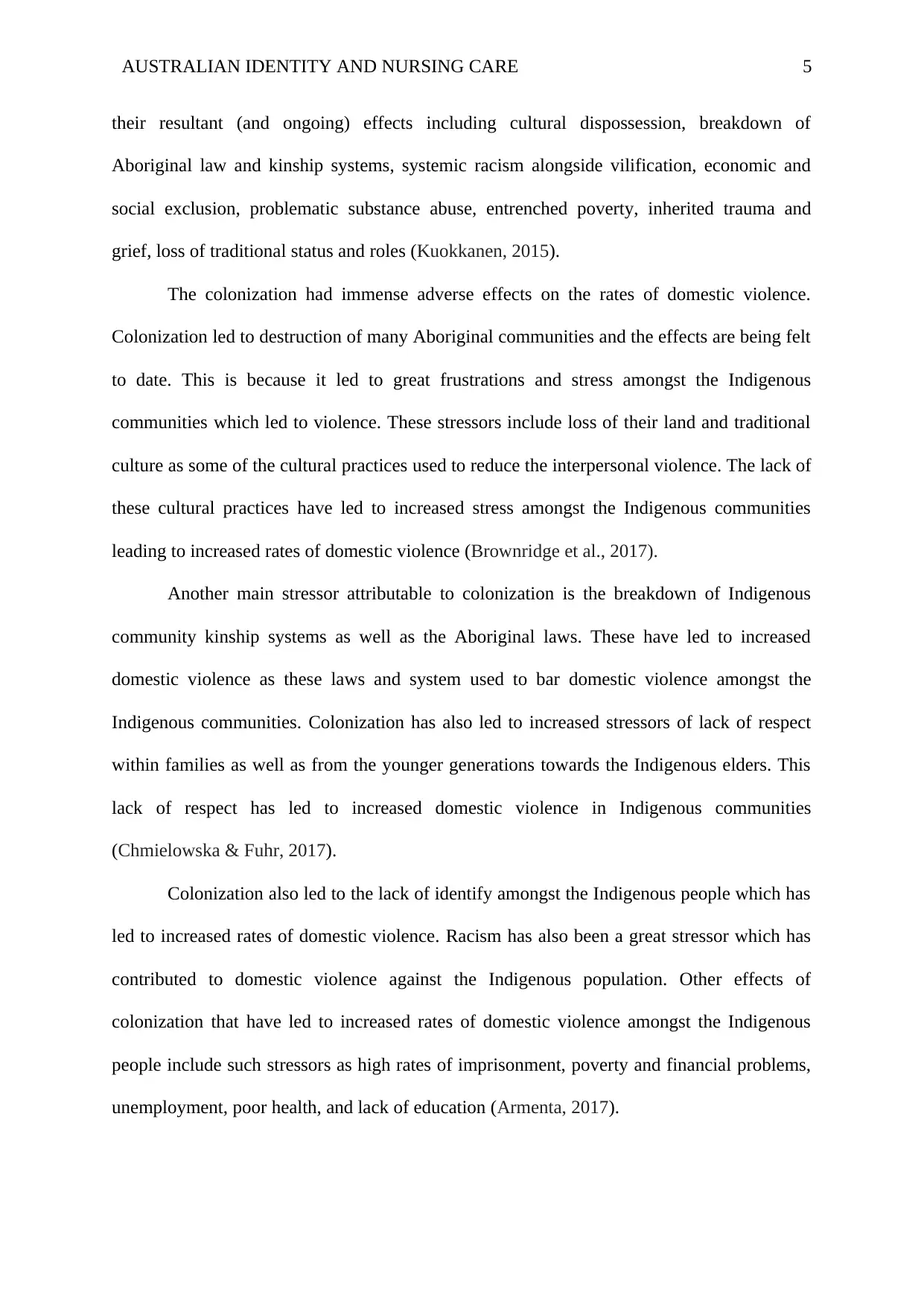
AUSTRALIAN IDENTITY AND NURSING CARE 5
their resultant (and ongoing) effects including cultural dispossession, breakdown of
Aboriginal law and kinship systems, systemic racism alongside vilification, economic and
social exclusion, problematic substance abuse, entrenched poverty, inherited trauma and
grief, loss of traditional status and roles (Kuokkanen, 2015).
The colonization had immense adverse effects on the rates of domestic violence.
Colonization led to destruction of many Aboriginal communities and the effects are being felt
to date. This is because it led to great frustrations and stress amongst the Indigenous
communities which led to violence. These stressors include loss of their land and traditional
culture as some of the cultural practices used to reduce the interpersonal violence. The lack of
these cultural practices have led to increased stress amongst the Indigenous communities
leading to increased rates of domestic violence (Brownridge et al., 2017).
Another main stressor attributable to colonization is the breakdown of Indigenous
community kinship systems as well as the Aboriginal laws. These have led to increased
domestic violence as these laws and system used to bar domestic violence amongst the
Indigenous communities. Colonization has also led to increased stressors of lack of respect
within families as well as from the younger generations towards the Indigenous elders. This
lack of respect has led to increased domestic violence in Indigenous communities
(Chmielowska & Fuhr, 2017).
Colonization also led to the lack of identify amongst the Indigenous people which has
led to increased rates of domestic violence. Racism has also been a great stressor which has
contributed to domestic violence against the Indigenous population. Other effects of
colonization that have led to increased rates of domestic violence amongst the Indigenous
people include such stressors as high rates of imprisonment, poverty and financial problems,
unemployment, poor health, and lack of education (Armenta, 2017).
their resultant (and ongoing) effects including cultural dispossession, breakdown of
Aboriginal law and kinship systems, systemic racism alongside vilification, economic and
social exclusion, problematic substance abuse, entrenched poverty, inherited trauma and
grief, loss of traditional status and roles (Kuokkanen, 2015).
The colonization had immense adverse effects on the rates of domestic violence.
Colonization led to destruction of many Aboriginal communities and the effects are being felt
to date. This is because it led to great frustrations and stress amongst the Indigenous
communities which led to violence. These stressors include loss of their land and traditional
culture as some of the cultural practices used to reduce the interpersonal violence. The lack of
these cultural practices have led to increased stress amongst the Indigenous communities
leading to increased rates of domestic violence (Brownridge et al., 2017).
Another main stressor attributable to colonization is the breakdown of Indigenous
community kinship systems as well as the Aboriginal laws. These have led to increased
domestic violence as these laws and system used to bar domestic violence amongst the
Indigenous communities. Colonization has also led to increased stressors of lack of respect
within families as well as from the younger generations towards the Indigenous elders. This
lack of respect has led to increased domestic violence in Indigenous communities
(Chmielowska & Fuhr, 2017).
Colonization also led to the lack of identify amongst the Indigenous people which has
led to increased rates of domestic violence. Racism has also been a great stressor which has
contributed to domestic violence against the Indigenous population. Other effects of
colonization that have led to increased rates of domestic violence amongst the Indigenous
people include such stressors as high rates of imprisonment, poverty and financial problems,
unemployment, poor health, and lack of education (Armenta, 2017).
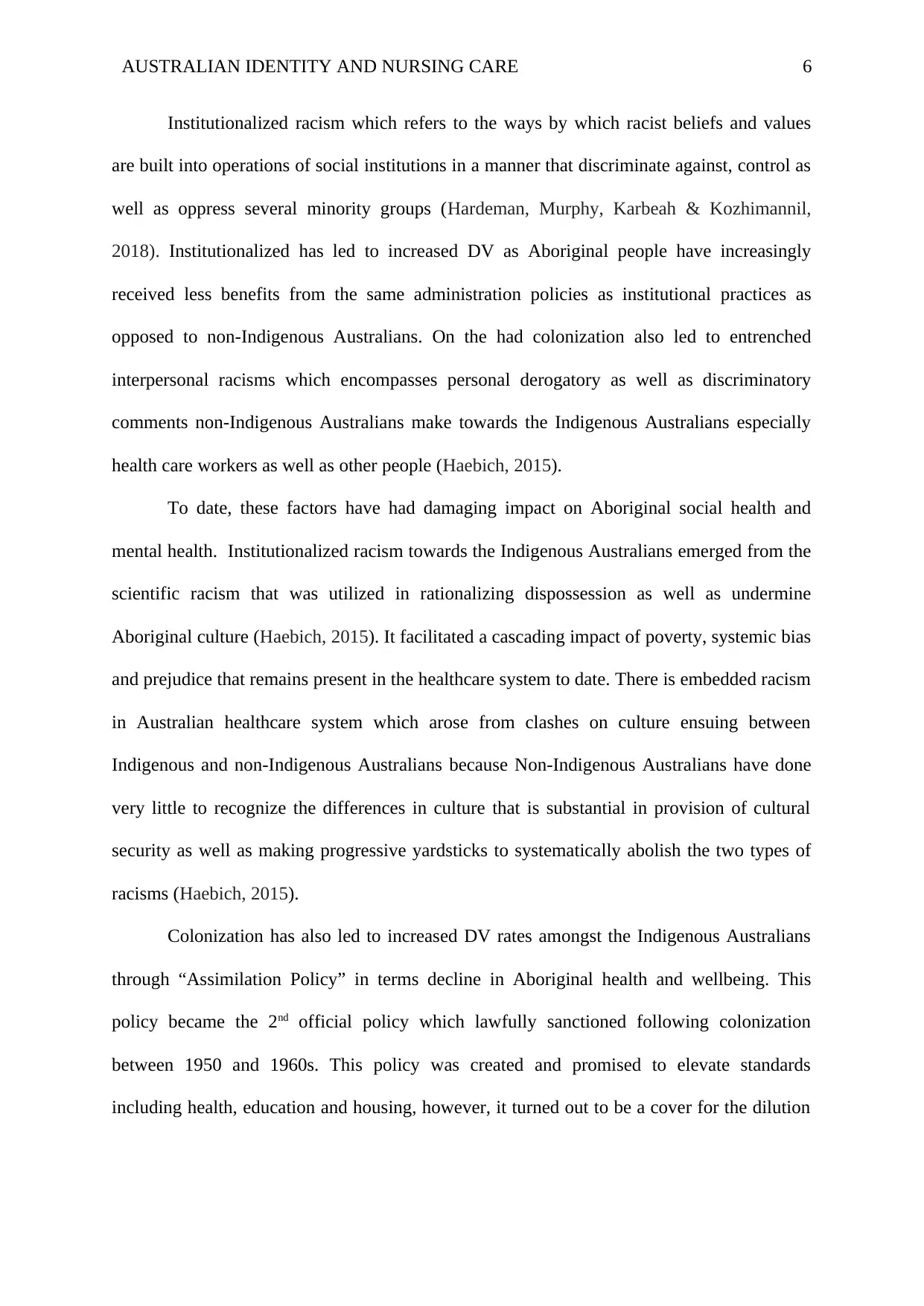
AUSTRALIAN IDENTITY AND NURSING CARE 6
Institutionalized racism which refers to the ways by which racist beliefs and values
are built into operations of social institutions in a manner that discriminate against, control as
well as oppress several minority groups (Hardeman, Murphy, Karbeah & Kozhimannil,
2018). Institutionalized has led to increased DV as Aboriginal people have increasingly
received less benefits from the same administration policies as institutional practices as
opposed to non-Indigenous Australians. On the had colonization also led to entrenched
interpersonal racisms which encompasses personal derogatory as well as discriminatory
comments non-Indigenous Australians make towards the Indigenous Australians especially
health care workers as well as other people (Haebich, 2015).
To date, these factors have had damaging impact on Aboriginal social health and
mental health. Institutionalized racism towards the Indigenous Australians emerged from the
scientific racism that was utilized in rationalizing dispossession as well as undermine
Aboriginal culture (Haebich, 2015). It facilitated a cascading impact of poverty, systemic bias
and prejudice that remains present in the healthcare system to date. There is embedded racism
in Australian healthcare system which arose from clashes on culture ensuing between
Indigenous and non-Indigenous Australians because Non-Indigenous Australians have done
very little to recognize the differences in culture that is substantial in provision of cultural
security as well as making progressive yardsticks to systematically abolish the two types of
racisms (Haebich, 2015).
Colonization has also led to increased DV rates amongst the Indigenous Australians
through “Assimilation Policy” in terms decline in Aboriginal health and wellbeing. This
policy became the 2nd official policy which lawfully sanctioned following colonization
between 1950 and 1960s. This policy was created and promised to elevate standards
including health, education and housing, however, it turned out to be a cover for the dilution
Institutionalized racism which refers to the ways by which racist beliefs and values
are built into operations of social institutions in a manner that discriminate against, control as
well as oppress several minority groups (Hardeman, Murphy, Karbeah & Kozhimannil,
2018). Institutionalized has led to increased DV as Aboriginal people have increasingly
received less benefits from the same administration policies as institutional practices as
opposed to non-Indigenous Australians. On the had colonization also led to entrenched
interpersonal racisms which encompasses personal derogatory as well as discriminatory
comments non-Indigenous Australians make towards the Indigenous Australians especially
health care workers as well as other people (Haebich, 2015).
To date, these factors have had damaging impact on Aboriginal social health and
mental health. Institutionalized racism towards the Indigenous Australians emerged from the
scientific racism that was utilized in rationalizing dispossession as well as undermine
Aboriginal culture (Haebich, 2015). It facilitated a cascading impact of poverty, systemic bias
and prejudice that remains present in the healthcare system to date. There is embedded racism
in Australian healthcare system which arose from clashes on culture ensuing between
Indigenous and non-Indigenous Australians because Non-Indigenous Australians have done
very little to recognize the differences in culture that is substantial in provision of cultural
security as well as making progressive yardsticks to systematically abolish the two types of
racisms (Haebich, 2015).
Colonization has also led to increased DV rates amongst the Indigenous Australians
through “Assimilation Policy” in terms decline in Aboriginal health and wellbeing. This
policy became the 2nd official policy which lawfully sanctioned following colonization
between 1950 and 1960s. This policy was created and promised to elevate standards
including health, education and housing, however, it turned out to be a cover for the dilution
⊘ This is a preview!⊘
Do you want full access?
Subscribe today to unlock all pages.

Trusted by 1+ million students worldwide
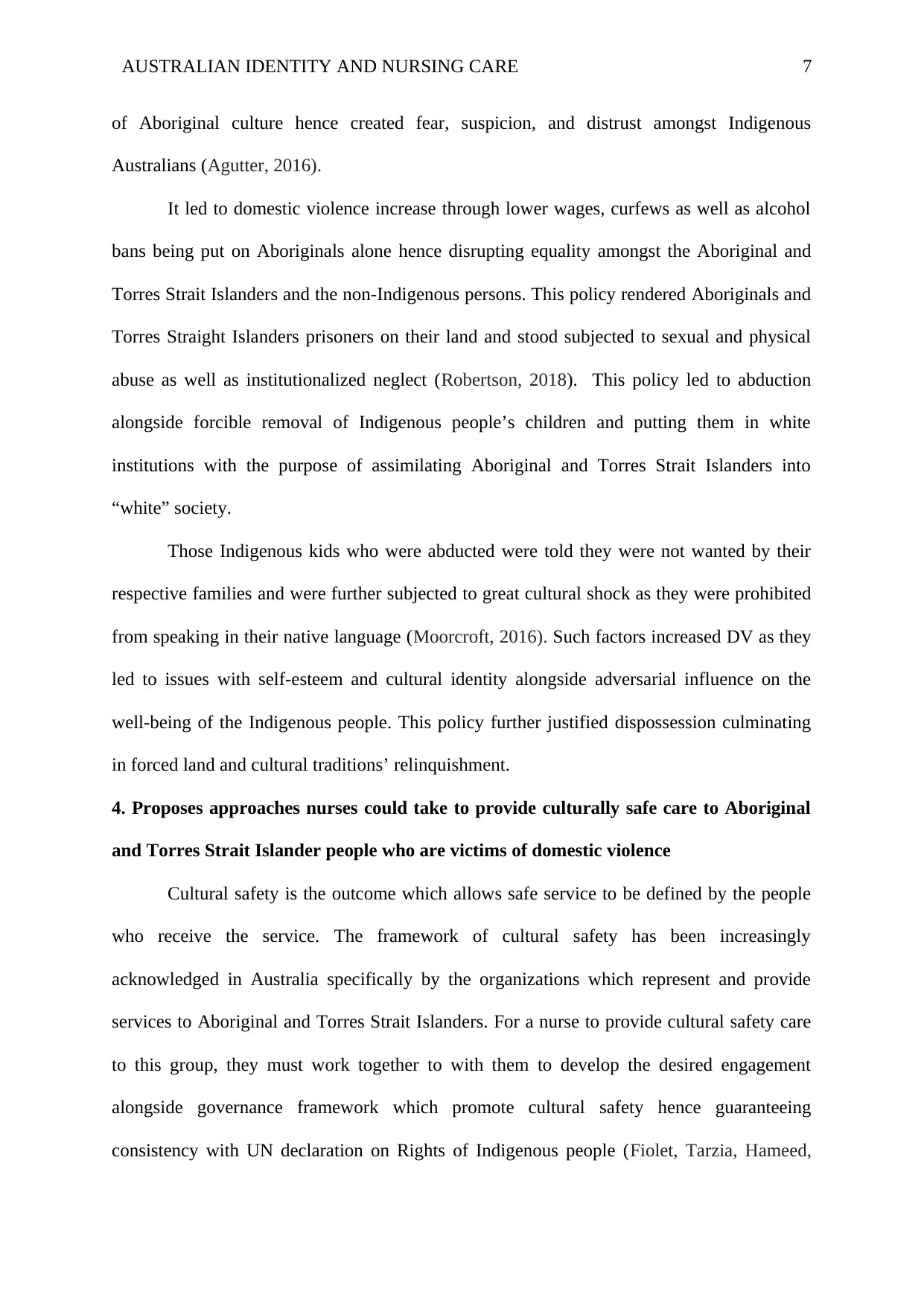
AUSTRALIAN IDENTITY AND NURSING CARE 7
of Aboriginal culture hence created fear, suspicion, and distrust amongst Indigenous
Australians (Agutter, 2016).
It led to domestic violence increase through lower wages, curfews as well as alcohol
bans being put on Aboriginals alone hence disrupting equality amongst the Aboriginal and
Torres Strait Islanders and the non-Indigenous persons. This policy rendered Aboriginals and
Torres Straight Islanders prisoners on their land and stood subjected to sexual and physical
abuse as well as institutionalized neglect (Robertson, 2018). This policy led to abduction
alongside forcible removal of Indigenous people’s children and putting them in white
institutions with the purpose of assimilating Aboriginal and Torres Strait Islanders into
“white” society.
Those Indigenous kids who were abducted were told they were not wanted by their
respective families and were further subjected to great cultural shock as they were prohibited
from speaking in their native language (Moorcroft, 2016). Such factors increased DV as they
led to issues with self-esteem and cultural identity alongside adversarial influence on the
well-being of the Indigenous people. This policy further justified dispossession culminating
in forced land and cultural traditions’ relinquishment.
4. Proposes approaches nurses could take to provide culturally safe care to Aboriginal
and Torres Strait Islander people who are victims of domestic violence
Cultural safety is the outcome which allows safe service to be defined by the people
who receive the service. The framework of cultural safety has been increasingly
acknowledged in Australia specifically by the organizations which represent and provide
services to Aboriginal and Torres Strait Islanders. For a nurse to provide cultural safety care
to this group, they must work together to with them to develop the desired engagement
alongside governance framework which promote cultural safety hence guaranteeing
consistency with UN declaration on Rights of Indigenous people (Fiolet, Tarzia, Hameed,
of Aboriginal culture hence created fear, suspicion, and distrust amongst Indigenous
Australians (Agutter, 2016).
It led to domestic violence increase through lower wages, curfews as well as alcohol
bans being put on Aboriginals alone hence disrupting equality amongst the Aboriginal and
Torres Strait Islanders and the non-Indigenous persons. This policy rendered Aboriginals and
Torres Straight Islanders prisoners on their land and stood subjected to sexual and physical
abuse as well as institutionalized neglect (Robertson, 2018). This policy led to abduction
alongside forcible removal of Indigenous people’s children and putting them in white
institutions with the purpose of assimilating Aboriginal and Torres Strait Islanders into
“white” society.
Those Indigenous kids who were abducted were told they were not wanted by their
respective families and were further subjected to great cultural shock as they were prohibited
from speaking in their native language (Moorcroft, 2016). Such factors increased DV as they
led to issues with self-esteem and cultural identity alongside adversarial influence on the
well-being of the Indigenous people. This policy further justified dispossession culminating
in forced land and cultural traditions’ relinquishment.
4. Proposes approaches nurses could take to provide culturally safe care to Aboriginal
and Torres Strait Islander people who are victims of domestic violence
Cultural safety is the outcome which allows safe service to be defined by the people
who receive the service. The framework of cultural safety has been increasingly
acknowledged in Australia specifically by the organizations which represent and provide
services to Aboriginal and Torres Strait Islanders. For a nurse to provide cultural safety care
to this group, they must work together to with them to develop the desired engagement
alongside governance framework which promote cultural safety hence guaranteeing
consistency with UN declaration on Rights of Indigenous people (Fiolet, Tarzia, Hameed,
Paraphrase This Document
Need a fresh take? Get an instant paraphrase of this document with our AI Paraphraser
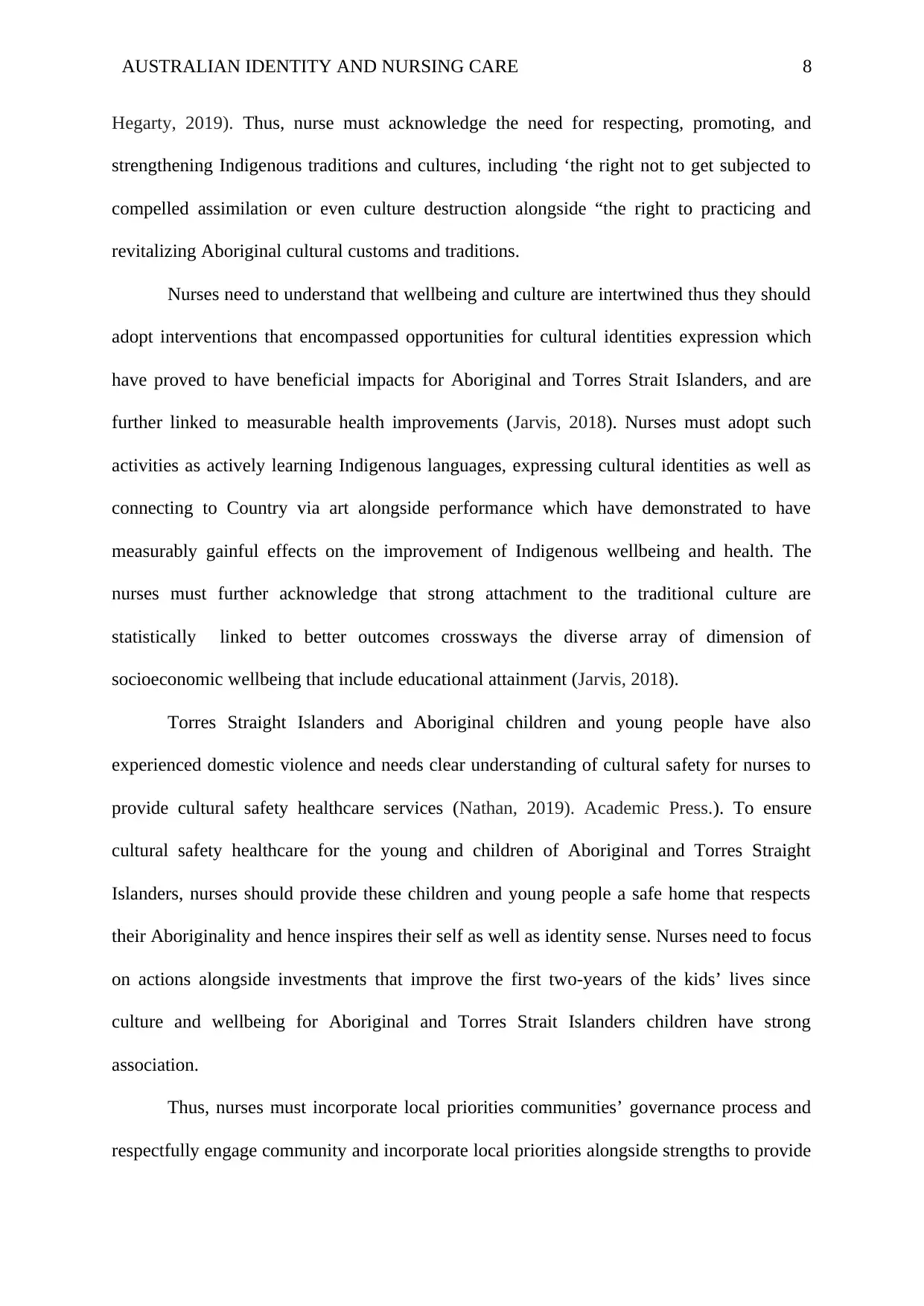
AUSTRALIAN IDENTITY AND NURSING CARE 8
Hegarty, 2019). Thus, nurse must acknowledge the need for respecting, promoting, and
strengthening Indigenous traditions and cultures, including ‘the right not to get subjected to
compelled assimilation or even culture destruction alongside “the right to practicing and
revitalizing Aboriginal cultural customs and traditions.
Nurses need to understand that wellbeing and culture are intertwined thus they should
adopt interventions that encompassed opportunities for cultural identities expression which
have proved to have beneficial impacts for Aboriginal and Torres Strait Islanders, and are
further linked to measurable health improvements (Jarvis, 2018). Nurses must adopt such
activities as actively learning Indigenous languages, expressing cultural identities as well as
connecting to Country via art alongside performance which have demonstrated to have
measurably gainful effects on the improvement of Indigenous wellbeing and health. The
nurses must further acknowledge that strong attachment to the traditional culture are
statistically linked to better outcomes crossways the diverse array of dimension of
socioeconomic wellbeing that include educational attainment (Jarvis, 2018).
Torres Straight Islanders and Aboriginal children and young people have also
experienced domestic violence and needs clear understanding of cultural safety for nurses to
provide cultural safety healthcare services (Nathan, 2019). Academic Press.). To ensure
cultural safety healthcare for the young and children of Aboriginal and Torres Straight
Islanders, nurses should provide these children and young people a safe home that respects
their Aboriginality and hence inspires their self as well as identity sense. Nurses need to focus
on actions alongside investments that improve the first two-years of the kids’ lives since
culture and wellbeing for Aboriginal and Torres Strait Islanders children have strong
association.
Thus, nurses must incorporate local priorities communities’ governance process and
respectfully engage community and incorporate local priorities alongside strengths to provide
Hegarty, 2019). Thus, nurse must acknowledge the need for respecting, promoting, and
strengthening Indigenous traditions and cultures, including ‘the right not to get subjected to
compelled assimilation or even culture destruction alongside “the right to practicing and
revitalizing Aboriginal cultural customs and traditions.
Nurses need to understand that wellbeing and culture are intertwined thus they should
adopt interventions that encompassed opportunities for cultural identities expression which
have proved to have beneficial impacts for Aboriginal and Torres Strait Islanders, and are
further linked to measurable health improvements (Jarvis, 2018). Nurses must adopt such
activities as actively learning Indigenous languages, expressing cultural identities as well as
connecting to Country via art alongside performance which have demonstrated to have
measurably gainful effects on the improvement of Indigenous wellbeing and health. The
nurses must further acknowledge that strong attachment to the traditional culture are
statistically linked to better outcomes crossways the diverse array of dimension of
socioeconomic wellbeing that include educational attainment (Jarvis, 2018).
Torres Straight Islanders and Aboriginal children and young people have also
experienced domestic violence and needs clear understanding of cultural safety for nurses to
provide cultural safety healthcare services (Nathan, 2019). Academic Press.). To ensure
cultural safety healthcare for the young and children of Aboriginal and Torres Straight
Islanders, nurses should provide these children and young people a safe home that respects
their Aboriginality and hence inspires their self as well as identity sense. Nurses need to focus
on actions alongside investments that improve the first two-years of the kids’ lives since
culture and wellbeing for Aboriginal and Torres Strait Islanders children have strong
association.
Thus, nurses must incorporate local priorities communities’ governance process and
respectfully engage community and incorporate local priorities alongside strengths to provide
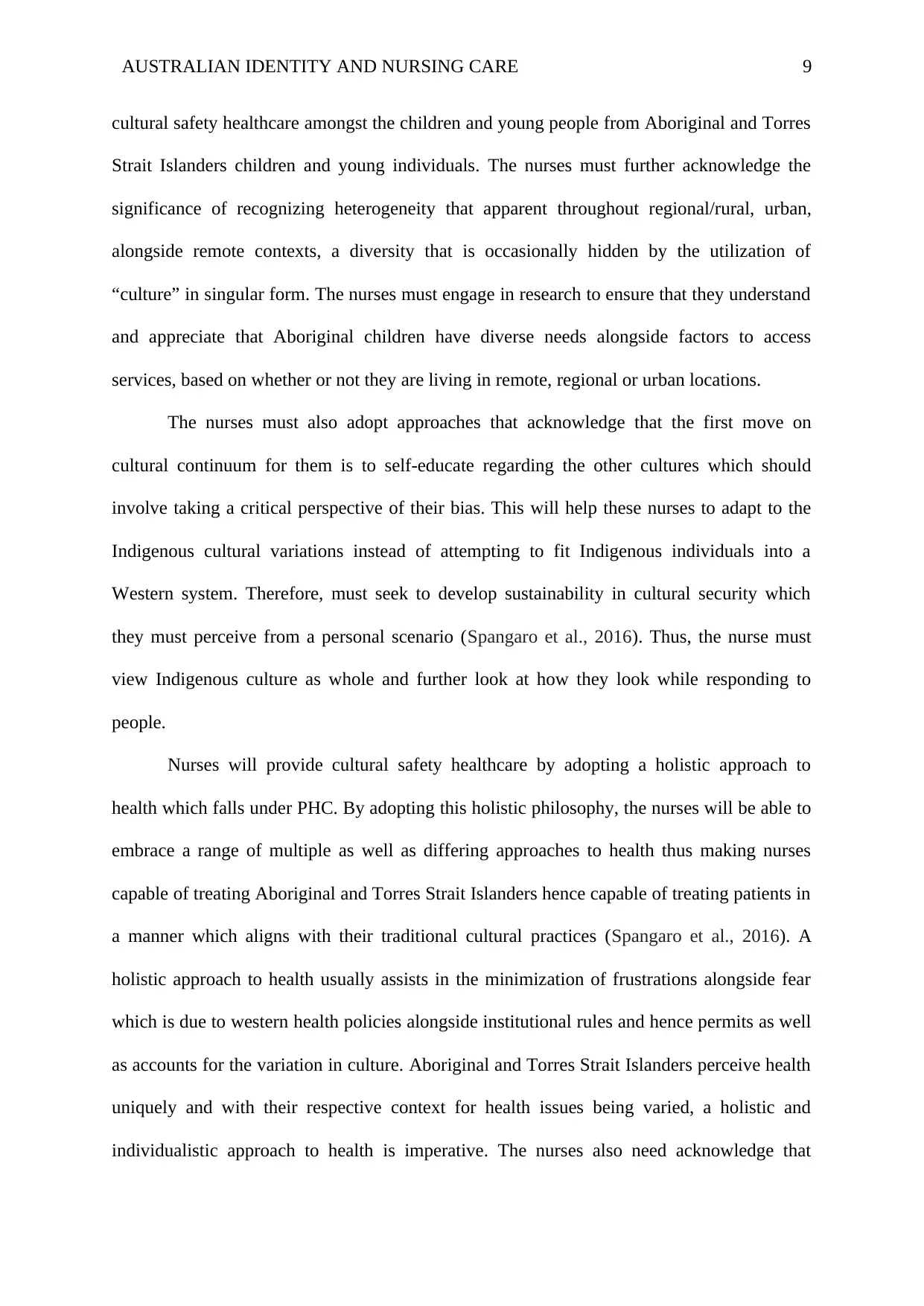
AUSTRALIAN IDENTITY AND NURSING CARE 9
cultural safety healthcare amongst the children and young people from Aboriginal and Torres
Strait Islanders children and young individuals. The nurses must further acknowledge the
significance of recognizing heterogeneity that apparent throughout regional/rural, urban,
alongside remote contexts, a diversity that is occasionally hidden by the utilization of
“culture” in singular form. The nurses must engage in research to ensure that they understand
and appreciate that Aboriginal children have diverse needs alongside factors to access
services, based on whether or not they are living in remote, regional or urban locations.
The nurses must also adopt approaches that acknowledge that the first move on
cultural continuum for them is to self-educate regarding the other cultures which should
involve taking a critical perspective of their bias. This will help these nurses to adapt to the
Indigenous cultural variations instead of attempting to fit Indigenous individuals into a
Western system. Therefore, must seek to develop sustainability in cultural security which
they must perceive from a personal scenario (Spangaro et al., 2016). Thus, the nurse must
view Indigenous culture as whole and further look at how they look while responding to
people.
Nurses will provide cultural safety healthcare by adopting a holistic approach to
health which falls under PHC. By adopting this holistic philosophy, the nurses will be able to
embrace a range of multiple as well as differing approaches to health thus making nurses
capable of treating Aboriginal and Torres Strait Islanders hence capable of treating patients in
a manner which aligns with their traditional cultural practices (Spangaro et al., 2016). A
holistic approach to health usually assists in the minimization of frustrations alongside fear
which is due to western health policies alongside institutional rules and hence permits as well
as accounts for the variation in culture. Aboriginal and Torres Strait Islanders perceive health
uniquely and with their respective context for health issues being varied, a holistic and
individualistic approach to health is imperative. The nurses also need acknowledge that
cultural safety healthcare amongst the children and young people from Aboriginal and Torres
Strait Islanders children and young individuals. The nurses must further acknowledge the
significance of recognizing heterogeneity that apparent throughout regional/rural, urban,
alongside remote contexts, a diversity that is occasionally hidden by the utilization of
“culture” in singular form. The nurses must engage in research to ensure that they understand
and appreciate that Aboriginal children have diverse needs alongside factors to access
services, based on whether or not they are living in remote, regional or urban locations.
The nurses must also adopt approaches that acknowledge that the first move on
cultural continuum for them is to self-educate regarding the other cultures which should
involve taking a critical perspective of their bias. This will help these nurses to adapt to the
Indigenous cultural variations instead of attempting to fit Indigenous individuals into a
Western system. Therefore, must seek to develop sustainability in cultural security which
they must perceive from a personal scenario (Spangaro et al., 2016). Thus, the nurse must
view Indigenous culture as whole and further look at how they look while responding to
people.
Nurses will provide cultural safety healthcare by adopting a holistic approach to
health which falls under PHC. By adopting this holistic philosophy, the nurses will be able to
embrace a range of multiple as well as differing approaches to health thus making nurses
capable of treating Aboriginal and Torres Strait Islanders hence capable of treating patients in
a manner which aligns with their traditional cultural practices (Spangaro et al., 2016). A
holistic approach to health usually assists in the minimization of frustrations alongside fear
which is due to western health policies alongside institutional rules and hence permits as well
as accounts for the variation in culture. Aboriginal and Torres Strait Islanders perceive health
uniquely and with their respective context for health issues being varied, a holistic and
individualistic approach to health is imperative. The nurses also need acknowledge that
⊘ This is a preview!⊘
Do you want full access?
Subscribe today to unlock all pages.

Trusted by 1+ million students worldwide
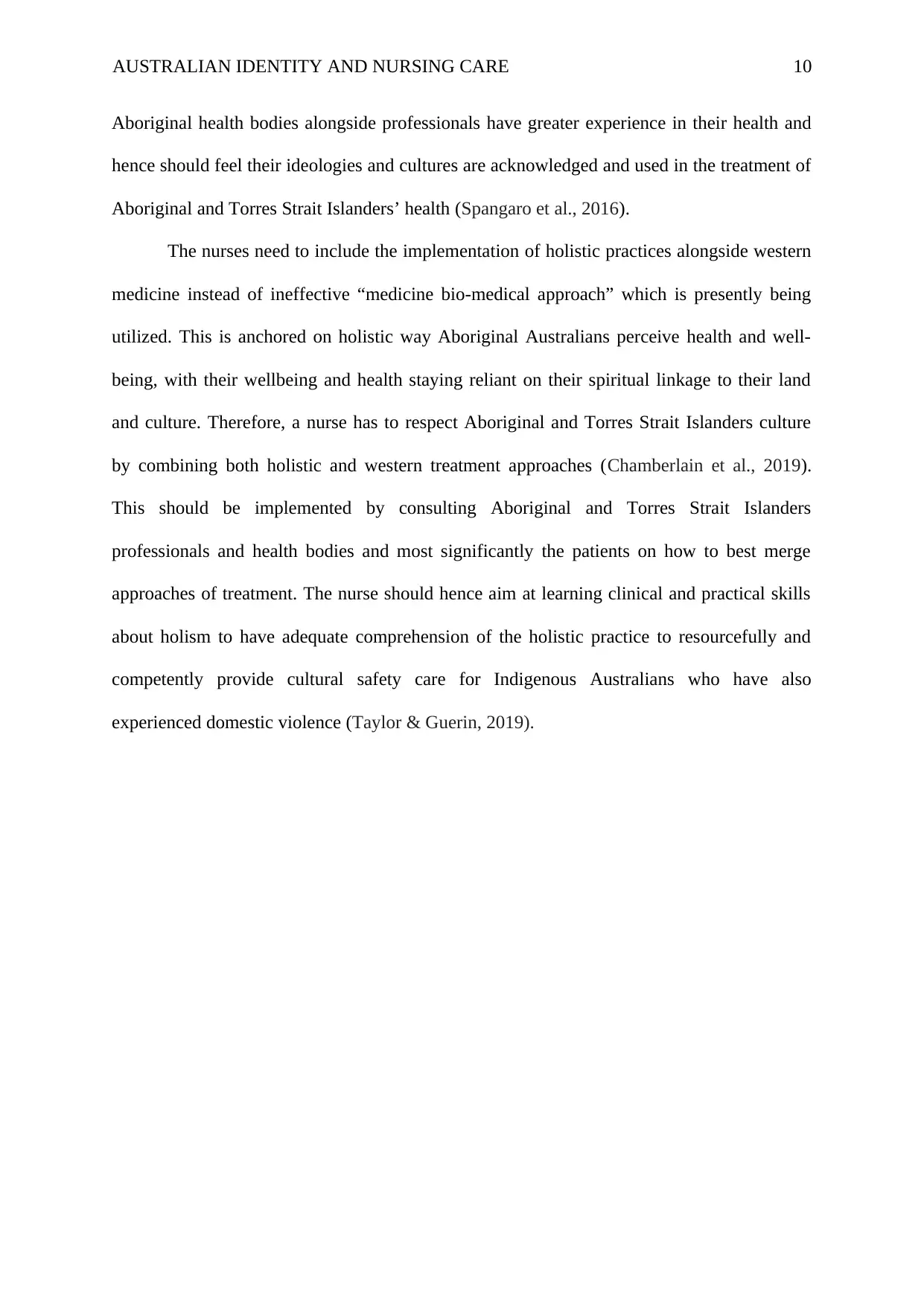
AUSTRALIAN IDENTITY AND NURSING CARE 10
Aboriginal health bodies alongside professionals have greater experience in their health and
hence should feel their ideologies and cultures are acknowledged and used in the treatment of
Aboriginal and Torres Strait Islanders’ health (Spangaro et al., 2016).
The nurses need to include the implementation of holistic practices alongside western
medicine instead of ineffective “medicine bio-medical approach” which is presently being
utilized. This is anchored on holistic way Aboriginal Australians perceive health and well-
being, with their wellbeing and health staying reliant on their spiritual linkage to their land
and culture. Therefore, a nurse has to respect Aboriginal and Torres Strait Islanders culture
by combining both holistic and western treatment approaches (Chamberlain et al., 2019).
This should be implemented by consulting Aboriginal and Torres Strait Islanders
professionals and health bodies and most significantly the patients on how to best merge
approaches of treatment. The nurse should hence aim at learning clinical and practical skills
about holism to have adequate comprehension of the holistic practice to resourcefully and
competently provide cultural safety care for Indigenous Australians who have also
experienced domestic violence (Taylor & Guerin, 2019).
Aboriginal health bodies alongside professionals have greater experience in their health and
hence should feel their ideologies and cultures are acknowledged and used in the treatment of
Aboriginal and Torres Strait Islanders’ health (Spangaro et al., 2016).
The nurses need to include the implementation of holistic practices alongside western
medicine instead of ineffective “medicine bio-medical approach” which is presently being
utilized. This is anchored on holistic way Aboriginal Australians perceive health and well-
being, with their wellbeing and health staying reliant on their spiritual linkage to their land
and culture. Therefore, a nurse has to respect Aboriginal and Torres Strait Islanders culture
by combining both holistic and western treatment approaches (Chamberlain et al., 2019).
This should be implemented by consulting Aboriginal and Torres Strait Islanders
professionals and health bodies and most significantly the patients on how to best merge
approaches of treatment. The nurse should hence aim at learning clinical and practical skills
about holism to have adequate comprehension of the holistic practice to resourcefully and
competently provide cultural safety care for Indigenous Australians who have also
experienced domestic violence (Taylor & Guerin, 2019).
Paraphrase This Document
Need a fresh take? Get an instant paraphrase of this document with our AI Paraphraser
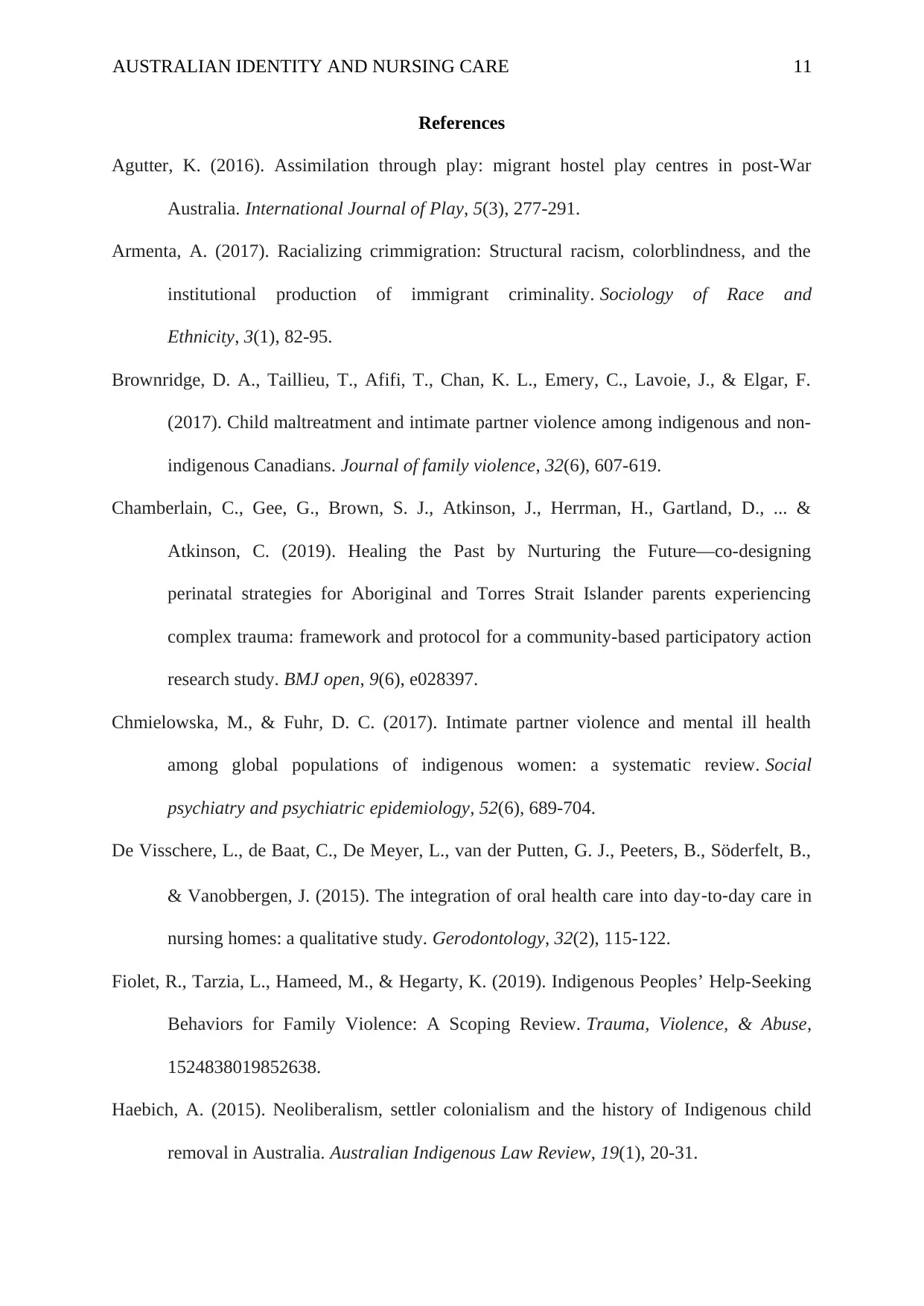
AUSTRALIAN IDENTITY AND NURSING CARE 11
References
Agutter, K. (2016). Assimilation through play: migrant hostel play centres in post-War
Australia. International Journal of Play, 5(3), 277-291.
Armenta, A. (2017). Racializing crimmigration: Structural racism, colorblindness, and the
institutional production of immigrant criminality. Sociology of Race and
Ethnicity, 3(1), 82-95.
Brownridge, D. A., Taillieu, T., Afifi, T., Chan, K. L., Emery, C., Lavoie, J., & Elgar, F.
(2017). Child maltreatment and intimate partner violence among indigenous and non-
indigenous Canadians. Journal of family violence, 32(6), 607-619.
Chamberlain, C., Gee, G., Brown, S. J., Atkinson, J., Herrman, H., Gartland, D., ... &
Atkinson, C. (2019). Healing the Past by Nurturing the Future—co-designing
perinatal strategies for Aboriginal and Torres Strait Islander parents experiencing
complex trauma: framework and protocol for a community-based participatory action
research study. BMJ open, 9(6), e028397.
Chmielowska, M., & Fuhr, D. C. (2017). Intimate partner violence and mental ill health
among global populations of indigenous women: a systematic review. Social
psychiatry and psychiatric epidemiology, 52(6), 689-704.
De Visschere, L., de Baat, C., De Meyer, L., van der Putten, G. J., Peeters, B., Söderfelt, B.,
& Vanobbergen, J. (2015). The integration of oral health care into day‐to‐day care in
nursing homes: a qualitative study. Gerodontology, 32(2), 115-122.
Fiolet, R., Tarzia, L., Hameed, M., & Hegarty, K. (2019). Indigenous Peoples’ Help-Seeking
Behaviors for Family Violence: A Scoping Review. Trauma, Violence, & Abuse,
1524838019852638.
Haebich, A. (2015). Neoliberalism, settler colonialism and the history of Indigenous child
removal in Australia. Australian Indigenous Law Review, 19(1), 20-31.
References
Agutter, K. (2016). Assimilation through play: migrant hostel play centres in post-War
Australia. International Journal of Play, 5(3), 277-291.
Armenta, A. (2017). Racializing crimmigration: Structural racism, colorblindness, and the
institutional production of immigrant criminality. Sociology of Race and
Ethnicity, 3(1), 82-95.
Brownridge, D. A., Taillieu, T., Afifi, T., Chan, K. L., Emery, C., Lavoie, J., & Elgar, F.
(2017). Child maltreatment and intimate partner violence among indigenous and non-
indigenous Canadians. Journal of family violence, 32(6), 607-619.
Chamberlain, C., Gee, G., Brown, S. J., Atkinson, J., Herrman, H., Gartland, D., ... &
Atkinson, C. (2019). Healing the Past by Nurturing the Future—co-designing
perinatal strategies for Aboriginal and Torres Strait Islander parents experiencing
complex trauma: framework and protocol for a community-based participatory action
research study. BMJ open, 9(6), e028397.
Chmielowska, M., & Fuhr, D. C. (2017). Intimate partner violence and mental ill health
among global populations of indigenous women: a systematic review. Social
psychiatry and psychiatric epidemiology, 52(6), 689-704.
De Visschere, L., de Baat, C., De Meyer, L., van der Putten, G. J., Peeters, B., Söderfelt, B.,
& Vanobbergen, J. (2015). The integration of oral health care into day‐to‐day care in
nursing homes: a qualitative study. Gerodontology, 32(2), 115-122.
Fiolet, R., Tarzia, L., Hameed, M., & Hegarty, K. (2019). Indigenous Peoples’ Help-Seeking
Behaviors for Family Violence: A Scoping Review. Trauma, Violence, & Abuse,
1524838019852638.
Haebich, A. (2015). Neoliberalism, settler colonialism and the history of Indigenous child
removal in Australia. Australian Indigenous Law Review, 19(1), 20-31.
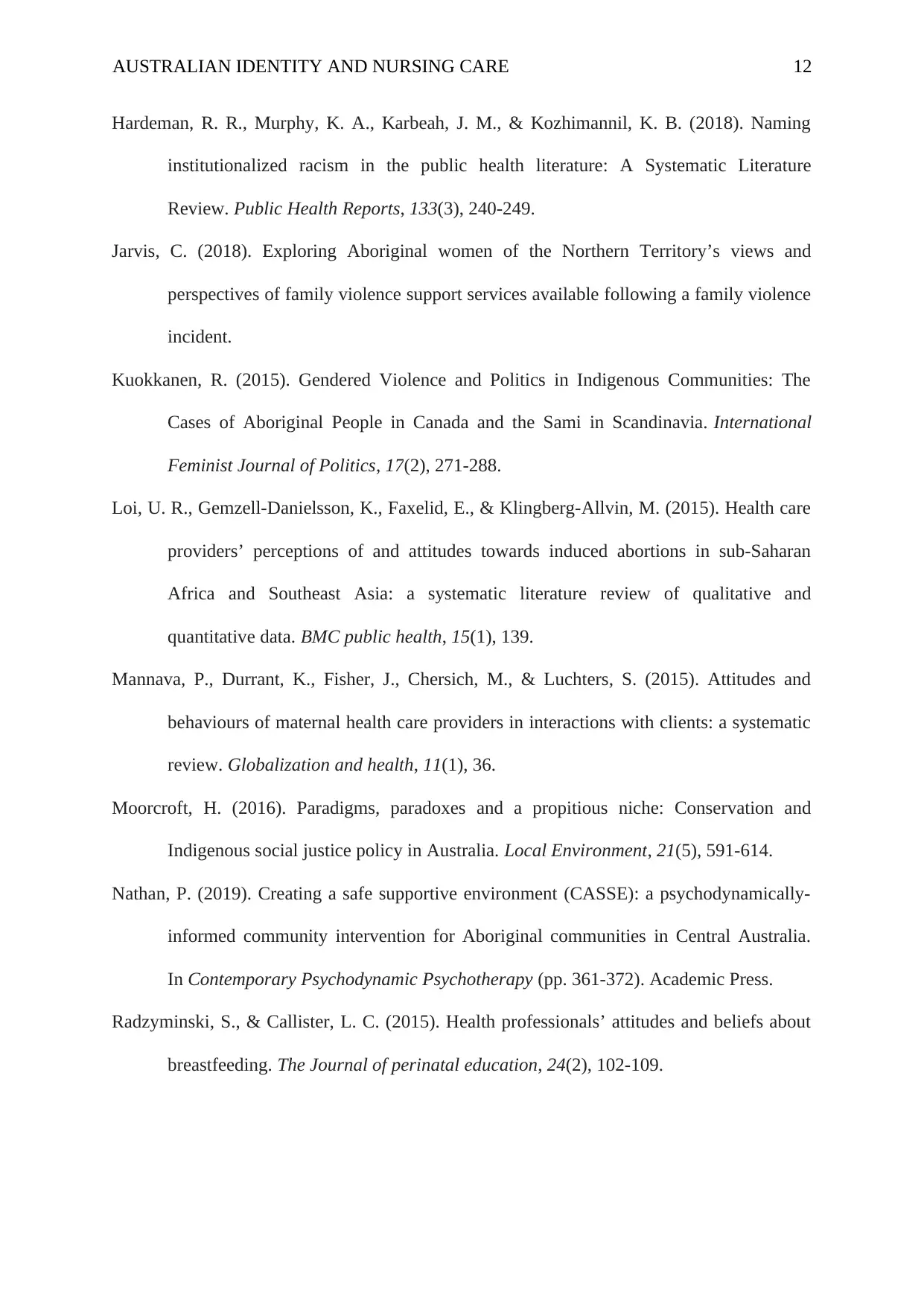
AUSTRALIAN IDENTITY AND NURSING CARE 12
Hardeman, R. R., Murphy, K. A., Karbeah, J. M., & Kozhimannil, K. B. (2018). Naming
institutionalized racism in the public health literature: A Systematic Literature
Review. Public Health Reports, 133(3), 240-249.
Jarvis, C. (2018). Exploring Aboriginal women of the Northern Territory’s views and
perspectives of family violence support services available following a family violence
incident.
Kuokkanen, R. (2015). Gendered Violence and Politics in Indigenous Communities: The
Cases of Aboriginal People in Canada and the Sami in Scandinavia. International
Feminist Journal of Politics, 17(2), 271-288.
Loi, U. R., Gemzell-Danielsson, K., Faxelid, E., & Klingberg-Allvin, M. (2015). Health care
providers’ perceptions of and attitudes towards induced abortions in sub-Saharan
Africa and Southeast Asia: a systematic literature review of qualitative and
quantitative data. BMC public health, 15(1), 139.
Mannava, P., Durrant, K., Fisher, J., Chersich, M., & Luchters, S. (2015). Attitudes and
behaviours of maternal health care providers in interactions with clients: a systematic
review. Globalization and health, 11(1), 36.
Moorcroft, H. (2016). Paradigms, paradoxes and a propitious niche: Conservation and
Indigenous social justice policy in Australia. Local Environment, 21(5), 591-614.
Nathan, P. (2019). Creating a safe supportive environment (CASSE): a psychodynamically-
informed community intervention for Aboriginal communities in Central Australia.
In Contemporary Psychodynamic Psychotherapy (pp. 361-372). Academic Press.
Radzyminski, S., & Callister, L. C. (2015). Health professionals’ attitudes and beliefs about
breastfeeding. The Journal of perinatal education, 24(2), 102-109.
Hardeman, R. R., Murphy, K. A., Karbeah, J. M., & Kozhimannil, K. B. (2018). Naming
institutionalized racism in the public health literature: A Systematic Literature
Review. Public Health Reports, 133(3), 240-249.
Jarvis, C. (2018). Exploring Aboriginal women of the Northern Territory’s views and
perspectives of family violence support services available following a family violence
incident.
Kuokkanen, R. (2015). Gendered Violence and Politics in Indigenous Communities: The
Cases of Aboriginal People in Canada and the Sami in Scandinavia. International
Feminist Journal of Politics, 17(2), 271-288.
Loi, U. R., Gemzell-Danielsson, K., Faxelid, E., & Klingberg-Allvin, M. (2015). Health care
providers’ perceptions of and attitudes towards induced abortions in sub-Saharan
Africa and Southeast Asia: a systematic literature review of qualitative and
quantitative data. BMC public health, 15(1), 139.
Mannava, P., Durrant, K., Fisher, J., Chersich, M., & Luchters, S. (2015). Attitudes and
behaviours of maternal health care providers in interactions with clients: a systematic
review. Globalization and health, 11(1), 36.
Moorcroft, H. (2016). Paradigms, paradoxes and a propitious niche: Conservation and
Indigenous social justice policy in Australia. Local Environment, 21(5), 591-614.
Nathan, P. (2019). Creating a safe supportive environment (CASSE): a psychodynamically-
informed community intervention for Aboriginal communities in Central Australia.
In Contemporary Psychodynamic Psychotherapy (pp. 361-372). Academic Press.
Radzyminski, S., & Callister, L. C. (2015). Health professionals’ attitudes and beliefs about
breastfeeding. The Journal of perinatal education, 24(2), 102-109.
⊘ This is a preview!⊘
Do you want full access?
Subscribe today to unlock all pages.

Trusted by 1+ million students worldwide
1 out of 13
Related Documents
Your All-in-One AI-Powered Toolkit for Academic Success.
+13062052269
info@desklib.com
Available 24*7 on WhatsApp / Email
![[object Object]](/_next/static/media/star-bottom.7253800d.svg)
Unlock your academic potential
Copyright © 2020–2025 A2Z Services. All Rights Reserved. Developed and managed by ZUCOL.





